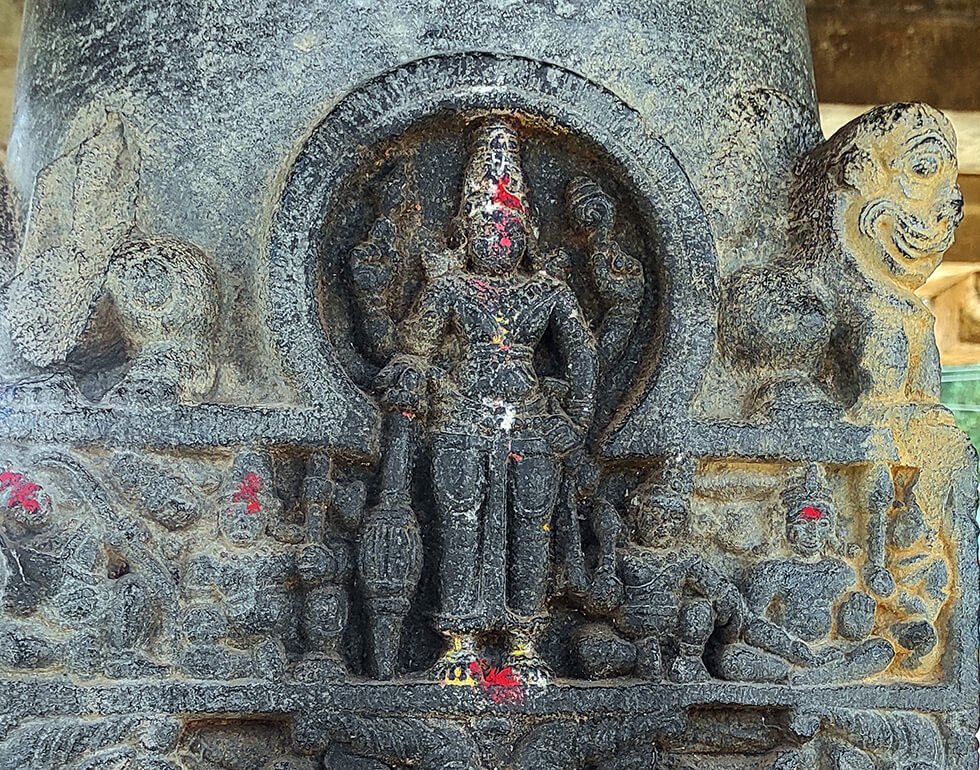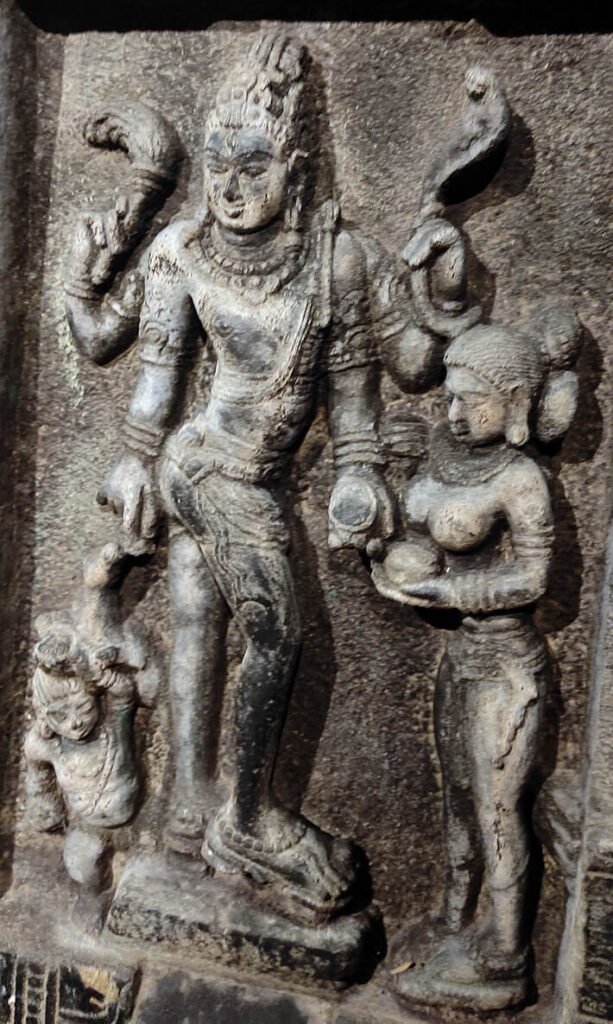
History of Nolamba
The history of Nolambalu is determined by geographical location. Their territory known as Nolambavadi included the modern districts of Tumkur, Chitradurga and Anantapur. They were therefore forced to play the role of buffer states between their neighbors the Banas and Vaidambas, as well as the great powers of the Deccan and South India. North of the Tungabhadra was the militant kingdom of the Rashtrakutas, who were later ousted by the Chalukyas on a less warlike basis in 975 A.D.
In the south the Pallavas, their successors, the Cholas and the Western Gangas attacked equally. Only when the powers were backfired or encroached upon elsewhere, the feudal lords could briefly enjoy independence. One such movement was in the 8th century A.D. Medium:
The Pallavas were relatively weak and the Rashtrakutas had only recently come to power. It was during this time that the Nolambas, who claimed to belong to the Pallava family, first appeared in Nolambalge, which later grew into Nolambavadi with 32000 villages. The first three rulers were western Ganga vassals and Rashtrakutas, who were in the ascendant.
The fourth Nolamba, Polachora, Western Ganga, married Jayabbe, daughter of Rajamalla I (817-853 A.D.). Polachora, though a vassal, was clearly a powerful ruler, and extended his territory southwards to include the Kolar district. Mahendra, his son by the Ganga princess, was the greatest of the Nolambas. He attacked his neighbours, the Vaidambas and the Batas, and claimed to have destroyed the latter. Certainly his kingdom included parts of Kolar and Bangalore districts and Dharmapuri in Salem district where his inscriptions are located. Finally he felt strong enough to refuse even nominal allegiance in the western Ganges. But he was defeated and killed by Nitimarga II (907-935 A.D.).

His son Nanniga (circa 918-938 A.D) seems to have made it with his overloads and helped them in their wars. The province of Nolambavadi was first mentioned during the reign of Nanniga. His successor Dilipa was defeated by the great Rashtrakuta Krishna III in 940 A.D. In the famous battle of Takkolam in 949 he defeated the rising power of the Cholas with the help of the Western Ganges. Dilipa’s successor Nanni was equally unfortunate.
Western Ganga Narasimha III (960-974 A.D.) is said to have destroyed the Nolamba family and escaped the massacre of the three princes, nothing is heard of the Nolambas till the next century.


Then there were three generations of kings, and then the vassals of the Chalukyas. As they took part in much of the fierce warfare between their masters and the Cholas, and were often occupied by Rajaraja and Rajadhiraja, the latter seem to have maintained their allegiance to the Chalukyas.
The role played by the Nolambs in South Indian political history may not be unique. Their art, though little known, is of great importance, and not only for its intrinsic beauty. The Rashtrakutas continued the wonderful tradition of early Chalukya art, but unfortunately only a few of their monuments survive. Not until the later Chalukyas are we again on firm ground. It is precisely this vacant period of the 9th-10th century – which was occupied by Nolamba art. And the Nolambas, whatever their political allegiance, were heirs to the Deccan tradition, which they developed and transmitted as far south as the Kolar district.
Nowhere has Nolamba sculpture been put to better use than at Hemavati. Unfortunately this is equally true of architecture. The main cluster of three temples to the north-east of the village lost their gopurams (sikaras) in the early hours of the morning.
To appreciate the architectural quality of Nolamba one has to travel 60 miles south of Nandi in Kolar district. The Bhonganadesvara shrine, which together with the neighboring Arunachalesvara forms the most beautiful group in the old Mysore state, gives a good idea of the beauty of the Nolamba temple when clean and complete.
There are two architectural features that inspired Nolamba artists and both are better represented elsewhere than at Hemavati. Although the Nolamba pillar derives from Rashtrakuta examples such as the Jain temple at Pattadakal or the Navalinga temple at Kukkanoor, it is crafted with meticulous innovation and meticulous craftsmanship. The clean base mouldings, the attractive turned capitals and the crisp and delicate decoration of the squareshafts are well detailed by the four pillars, now supporting the small modern pavilion in front of the main temple (back cover).
No wonder these magnificent pillars were admired and desired by Nolambula’s contemporaries. From one of his invasions of the region, Rajendra, the great Chola conqueror, plundered no less than forty-four of them to adorn the fine temple at Tiruvadi, seven miles north of Thanjavur, which still stand as mute testimony to his admiration. Nolamba art.
Perhaps the most important feature of Nolamba architecture is the use of pierced stone windows to provide soft, diffused light to the hall (navaranga) and shrine (sukhanasi). This type of window was already used by the early Chalukyas in geometric and flowing, organic forms. Beautiful examples of both can be seen in the famous Virupaksha temple at Pattadakal, built by Queen Vikramaditya II (733-746 AD). In the hands of Nolamba artists, these decorative designs reached the level of major works of art.
One of the most striking forms is the regularly curved and gently cusped tendril, which contains figures of dancers and musicians (Plate 12). A more perfect union of lovingly observed natural forms and controlled design is hard to imagine.
Similar pierced windows were also used in the Bhoganandisvara and Arunachalesvara Kshetras at Nandi already mentioned. Natesu has great beauty. The Cholas admired these windows as vertical pillars.
A fine example, like that on Plate 12, can be seen in the Kachesvara temple at Kanjivarma. A few others, of the usual greenish bluish basalt used by the Nolambs, are set up in a covered hall in front of the main hall of the Rajarajeswara temple at Tanjore.
The Mallikarjuna temple door to the south of the main temple (Plate 20) is well designed and predates the Rashtrakuta doors at Pattadakal, a Jain temple. The alternation of elaborately cut and plain beveled surfaces gives a striking effect. Famous features include two dwarfs mounted on elephants and doors and windows. These dwarves carried Kuvera, the treasurer of two bees, a lotus flower and a conch, a motif of the Chalukyas, which was later adopted by the Cholas. The central figure of Gajalakshmi on the Mallikarjuna Gate also has two dwarfs.
There are many sculptures about the site in small modern cells within the main temple complex. The southern type Surya (Plate 13) is best barefoot and holding his lotus flowers (missing) very low. There is no more attractive image of this diety in Indian art.
There are also four sculptures of Nandi, the vehicle of Lord Shiva, of monumental size and concept. Two of the best are illustrated here (Plates 14 and 15). Beautiful bells are again characteristic of the Chalukyas. Scattered throughout the site is a complete set of seven mothers (sapta matrika). They display power and majesty (Plates 16 and 17) comparable to late Pallava and early Chola deities.
From the sculptures in the main temple we select Mahishasuramardhi (Plate 18), a perfect example of the Indian genius for three-dimensional form, and a charming group of Naga and Nagini with intertwined tails (Plate 19). 10th century A.D. Here is only the part illustrated.

In Hemavati
Famous Shiva Temples
Siddeshwara Swamy Temple
During Chaitram and Vaisakh months, it is wonderful to see the sunlight touching the 5.8 feet tall Siddeshwara Swamy during the dusk.
Doddeswara Swamy Temple
Sri Doddeswara Swamy Temple has Saiva Purana stories as well as Vishnava Purana stories engraved in them. Opposite the largest Nandi temple.
Chela Bhairava Swamy Temple
It is believed that if jaggery is offered in the temple of Sri Chelabhairavaswamy, the Swami will protect their house from snakes, scorpions and any other poisonous insects.
Malleswara Swamy Temple
In the Malleswara Swamy temple, the lingam shines brightly with the rays of the morning sun. It is on the left side of Doddeswara temple.
Virupaksheswara Temple
The temple is famous for its sculpture. This temple is on the right side of Doddeswara Swamy temple. In the mandapa opposite to Shivalinga, Nandi's hand makes a sound.
Navakotamma Temple
People here worship Navakotamma as the younger sister of Lord Siddeshwara. People here perform puja to Navakotamma to get children.


